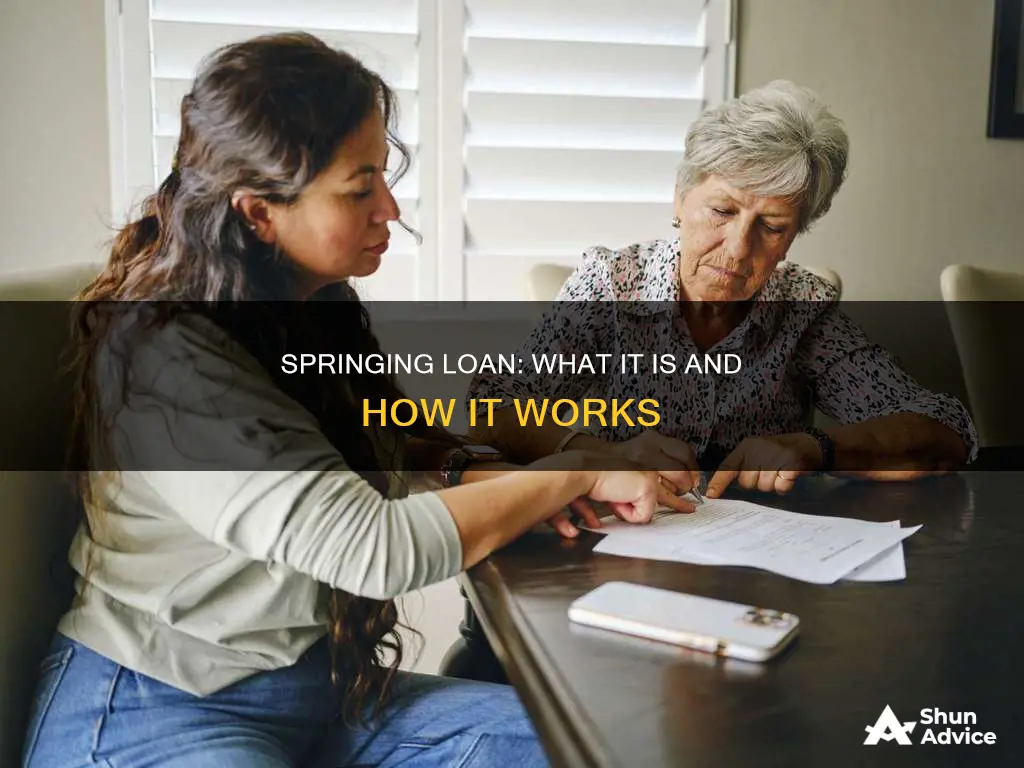
A springing loan is a type of loan guarantee that is only activated when certain events occur, such as a borrower violating operating covenants, failing to meet net worth requirements, or filing for bankruptcy. In these cases, the borrower's guarantor becomes partially or fully responsible for the loan obligation. Springing loans can be used as a backup facility to refinance borrowings when market conditions are unattractive. They can also be used to manage financing costs in a heightened rates environment, providing flexibility and funding certainty. Springing caps have been employed in new loans to reduce upfront hedging costs, with borrowers weighing the timing of purchasing springing caps to manage risk.
What is a Springing Loan?
| Characteristics | Values |
|---|---|
| Definition | A springing term loan is a loan that comes into effect when a pre-specified event occurs. |
| Use Case | It can be used as a backup facility, for example, to refinance borrowings when market conditions are unfavourable. |
| Example | Balanced Commercial Property Trust (BCPT) used a springing loan to refinance existing debt and maintain flexibility ahead of maturity and continuation votes. |
| Springing Recourse or Springing Liability | A form of loan guarantee that becomes enforceable by a lender when certain default or credit events occur, such as bankruptcy or failure to meet net worth requirements. |
| Impact of Springing Recourse | When adverse events occur, the borrower's guarantor becomes partially or fully liable for the loan obligation, regardless of whether the loan is non-recourse or not. |
| Springing Interest Rate Cap | Borrowers may purchase a springing cap to mitigate the increased cost of interest rate caps. |
| Timing of Springing Cap Purchase | Borrowers' decisions on when to purchase a springing cap depend on their views on interest rate movements and volatility. |
| Negotiation and Adjustments | Clients may negotiate adjustments to springing cap provisions with lenders, who consider each situation individually, factoring in asset performance and relationships. |
What You'll Learn

Springing term loans are a form of loan guarantee
Springing term loans are often used as a backup facility, coming into effect when pre-specified events occur. For instance, a borrower may take out a springing term loan to refinance their existing debt when market conditions are unattractive. This allows them to maintain competitive pricing while retaining favourable terms from their existing loan. Springing term loans can provide flexibility and funding certainty, making them a valuable tool for managing financing costs in a heightened rates environment.
One example of a springing term loan is a "springing recourse" provision in a loan agreement. While the loan may be technically non-recourse, meaning the lender can only seize the property in the event of default, the springing recourse clause outlines conditions under which the liability transfers to the borrower's guarantor. This can include specific triggers such as filing for bankruptcy or failing to meet a minimum Debt Service Coverage Ratio (DSCR).
Another context in which springing loans are used is in floating-rate loan originations with hedge requirements. Springing caps have been employed to reduce upfront hedging costs. Borrowers must consider the timing of purchasing springing caps, weighing the option to buy a cap early to lock in a known cost against waiting until it is required or re-evaluating the purchase at a future date. Sensitivity analysis can help borrowers understand the potential range of future cap costs and better quantify the risk of deferring a cap purchase.
MCA Loans: Legal or Loan Sharking?
You may want to see also

They are only enforceable when certain events occur
A springing loan is a form of loan guarantee that is only enforceable when certain events occur, such as a borrower violating operating covenants, failing to meet net worth requirements, or filing for voluntary bankruptcy. In such cases, the borrower's guarantor becomes partially or fully liable for the loan obligation, regardless of whether the loan is non-recourse or not. For example, a borrower who violates the terms of their loan agreement by filing for bankruptcy may trigger a "springing recourse" clause, making them personally liable for the full loan balance.
Similarly, a springing term loan is a type of loan that only comes into effect upon the occurrence of a pre-specified event. For instance, a borrower may establish a springing term loan facility as a backup option if they need to refinance borrowings when market conditions are unattractive. In this case, the springing term loan allows the borrower to refinance their existing debt while maintaining competitive pricing and retaining favourable terms from their previous loan.
Another example of a springing loan is a non-recourse loan with a "springing recourse" provision. While the lender can only seize the property in the event of a default, the springing recourse clause outlines specific conditions under which the liability extends to the borrower's personal assets. This means that if the borrower violates certain terms, such as failing to meet a Minimum Debt Service Coverage Ratio (DSCR), the springing recourse clause is activated, and the borrower becomes personally liable for a portion or all of the outstanding loan balance.
Overall, springing loans provide a level of protection for lenders by allowing them to enforce loan obligations under certain adverse conditions. It is important for borrowers to understand the specific triggers of springing loans to avoid unexpected personal liability.
Steps to Becoming a Loan Signing Agent in Pennsylvania
You may want to see also

For example, if a borrower violates operating covenants
A springing loan is a type of loan guarantee that is only enforceable by a lender when certain default or credit events occur. These events may include a borrower violating operating covenants, failing to meet net worth requirements, or filing for voluntary bankruptcy. In such cases, the borrower's guarantor becomes partially or fully liable for the loan obligation.
Now, for a borrower to violate operating covenants means that they have failed to uphold the agreed-upon terms of a covenant. Covenants are agreements between multiple parties that create a legally binding agreement on how each party is to perform. In the context of loans, covenants are often put in place by lenders to protect themselves from borrowers defaulting on their obligations due to financial actions detrimental to themselves or the business.
There are two types of covenants: affirmative or positive covenants and negative covenants. An affirmative covenant is a clause in a loan contract that requires a borrower to perform specific actions, such as maintaining adequate levels of insurance or furnishing audited financial statements to the lender. On the other hand, negative covenants are put in place to restrict borrowers from taking certain actions that could result in the deterioration of their credit standing and ability to repay existing debt. Examples of such restricted actions include incurring additional liabilities or making large investments.
If a borrower violates a loan covenant, the lender has the right to declare a technical default and demand immediate repayment of the loan. This is known as a covenant breach. It is important to note that not all covenant breaches are created equal. Some breaches, such as late financial reporting, may be resolved quickly and have minimal impact on the borrower. However, more severe breaches, such as presenting fraudulent financial results to a lender, would be considered a severe technical default that could lead to legal action against the borrower.
Understanding Package Loans: What You Need to Know
You may want to see also

A springing loan can be used to refinance borrowings
A springing loan is a type of loan guarantee that is only enforceable by a lender when certain default or credit events occur. For instance, if a borrower violates operating covenants, does not meet net worth requirements, or files for voluntary bankruptcy. In such adverse events, the borrower's guarantor becomes partially or fully liable for the loan obligation.
Additionally, refinancing can also involve changing the duration of the loan or switching between a fixed-rate and an adjustable-rate mortgage. It is important to note that refinancing requires the borrower to approach their existing or new lender and complete a new loan application. The lender will then re-evaluate the borrower's income, credit history, and financial situation.
A springing loan can be particularly useful in the context of refinancing when market conditions are unattractive. For instance, if a borrower is facing unfavourable market conditions with high-interest rates, they may opt for a springing loan as a backup facility. This provides them with the flexibility to wait for more favourable market conditions while still having the option to refinance their existing borrowings.
In summary, a springing loan can be effectively utilised to refinance borrowings, especially when borrowers are navigating challenging market conditions or seeking to take advantage of improved terms, such as lower interest rates or extended loan durations.
Understanding Carry Back Loans: A Smart Financial Strategy?
You may want to see also

Springing interest rate cap requirements in CRE loans
A springing term loan is a loan that only comes into effect when a pre-specified event occurs. It can be established as a backup facility to refinance borrowings when market conditions are unattractive.
A springing interest rate cap is a loan requirement to purchase an interest rate cap post-closing if and only if the loan base rate (e.g. LIBOR or SOFR) crosses a predetermined threshold. They are typically negotiated when the lender requires a hedge, but the borrower does not want to incur the cost of the cap at loan closure. This is often because the upfront cost of the cap would impair the deal economics, or because the borrower believes that rates will not rise quickly enough to trigger the cap purchase requirement. For example, a requirement to purchase a 3.50% cap on SOFR through the initial maturity of a loan if SOFR reaches 2.50%.
The immediate benefit of such a structure is that the borrower avoids the upfront cost of the cap. Over the loan's term, they may avoid the cost entirely if rates don't cross the threshold triggering the purchase, or they may find that the cost of the cap is less than if they had purchased it upfront if rates do cross this threshold. With rising short-term rates, we expect these provisions in many loans to be triggered, requiring borrowers to purchase an interest rate cap.
Borrowers evaluating such a provision in a new loan origination should consider their view of the current forward curve, their expectations for paying off/refinancing the underlying debt, and their tolerance for risk and uncertainty in potential costs.
Interest rate volatility can also impact cap pricing. The term and strike rate of a cap, along with the market's expectations for future rates, can influence cap pricing. Interest rate volatility reflects the market-implied probability and the extent to which actual rates may deviate from the forward curve, potentially resulting in larger-than-anticipated payouts from the cap provider to the borrower.
Explore Rural Opportunities with a Development Loan
You may want to see also
Frequently asked questions
A springing loan is a loan that only comes into effect when a pre-specified event occurs. It can be used as a backup option when market conditions are unattractive.
A springing recourse is a form of loan guarantee that can be enforced by a lender when certain default or credit events occur, such as bankruptcy or failure to meet net worth requirements. In this case, the borrower's guarantor becomes partially or fully liable for the loan obligation.
Northern Horizon Development, a real estate firm, secured a $12 million bridge loan from Arctic Bank to redevelop a shopping plaza. The loan was non-recourse, but it included a springing recourse provision that made the managing partner personally liable if certain conditions were met, such as bankruptcy.
A springing interest rate cap is an approach used by borrowers and lenders to mitigate the increased cost of interest rate caps. It allows borrowers to lock in a known cost and provides protection against rising interest rates.
Springing loans provide flexibility and funding certainty. They can help manage financing costs in a heightened rates environment and reduce upfront hedging costs.







